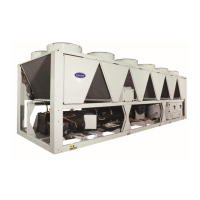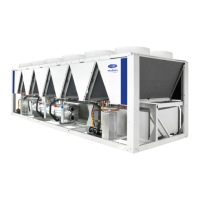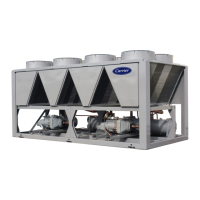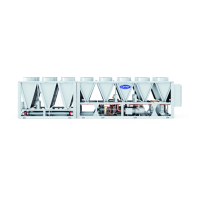Manufacturer reserves the right to discontinue, or change at any time, specifications or designs without notice and without incurring obligations.
Catalog No. 04-53300024-01 Printed in U.S.A. Form 30XW-1T Pg 1 11-09 Replaces: New
Controls, Start-Up, Operation, Service
and Troubleshooting
CONTENTS
Page
SAFETY CONSIDERATIONS . . . . . . . . . . . . . . . . . . . . . . 2
GENERAL . . . . . . . . . . . . . . . . . . . . . . . . . . . . . . . . . . . . . . 3-9
Conventions Used in This Manual. . . . . . . . . . . . . . . . 3
Display Module Usage . . . . . . . . . . . . . . . . . . . . . . . . . . . 3
• TOUCH PILOT™ DISPLAY
• NAVIGATOR™ DISPLAY MODULE
CONTROLS . . . . . . . . . . . . . . . . . . . . . . . . . . . . . . . . . . . 9-18
General . . . . . . . . . . . . . . . . . . . . . . . . . . . . . . . . . . . . . . . . . . 9
Main Base Board (MBB) . . . . . . . . . . . . . . . . . . . . . . . . . . 9
Compressor Protection Module (CPM) . . . . . . . . . . 10
Electronic Expansion Valve (EXV) Board . . . . . . . . 13
MLV/Condenser Board . . . . . . . . . . . . . . . . . . . . . . . . . . 15
Enable-Off-Remote Contact Switch (SW1). . . . . . . 16
Emergency On/Off Switch (SW2) . . . . . . . . . . . . . . . . 16
Energy Management Module (EMM) . . . . . . . . . . . . . 16
Local Equipment Network. . . . . . . . . . . . . . . . . . . . . . . 17
Board Addresses. . . . . . . . . . . . . . . . . . . . . . . . . . . . . . . . 17
Touch Pilot Display. . . . . . . . . . . . . . . . . . . . . . . . . . . . . . 17
Control Module Communication. . . . . . . . . . . . . . . . . 17
•RED LED
• GREEN LED
• YELLOW LED
Carrier Comfort Network
®
(CCN) Interface. . . . . . . 18
Remote Alarm and Alert Relays . . . . . . . . . . . . . . . . . 18
CONFIGURATION . . . . . . . . . . . . . . . . . . . . . . . . . . . . 18-46
Touch Pilot Operation Configuration Tables . . . . . 18
Machine Control Methods . . . . . . . . . . . . . . . . . . . . . . . 20
Machine On/Off Control . . . . . . . . . . . . . . . . . . . . . . . . . 20
• TOUCH PILOT MACHINE CONTROL
• NAVIGATOR DISPLAY MACHINE CONTROL
Entering Fluid Control Option . . . . . . . . . . . . . . . . . . . 25
Cooling Set Point Selection . . . . . . . . . . . . . . . . . . . . . 25
• SET POINT OCCUPANCY
Chilled Water Fluid Type Selection . . . . . . . . . . . . . . 27
• FRESH WATER
• BRINE OR GLYCOL OPERATION
Cooler Pump Control. . . . . . . . . . . . . . . . . . . . . . . . . . . . 28
• COOLER PUMP CONTROL CONFIRGURATIONS
Machine Start Delay . . . . . . . . . . . . . . . . . . . . . . . . . . . . . 29
Circuit/Compressor Staging and Loading . . . . . . . 29
• CIRCUIT/COMPRESSOR STAGING
• CIRCUIT/COMPRESSOR LOADING
Minimum Load Control . . . . . . . . . . . . . . . . . . . . . . . . . . 29
Dual Chiller Control . . . . . . . . . . . . . . . . . . . . . . . . . . . . . 29
• DUAL CHILLER CONTROL FOR PARALLEL
APPLICATIONS
• DUAL CHILLER PUMP CONTROL FOR PARALLEL
CHILLER APPLICATIONS
• DUAL CHILLER CONTROL FOR SERIES
APPLICATIONS
• DUAL CHILLER PUMP CONTROL FOR SERIES
CHILLER APPLICATIONS
Page
Ramp Loading . . . . . . . . . . . . . . . . . . . . . . . . . . . . . . . . . . 35
Temperature Reset . . . . . . . . . . . . . . . . . . . . . . . . . . . . . . 35
• RETURN WATER RESET
• SPACE TEMPERATURE RESET
• 4-20 mA TEMPERATURE RESET
Demand Limit . . . . . . . . . . . . . . . . . . . . . . . . . . . . . . . . . . . 39
• SWITCH CONTROLLED DEMAND LIMIT
• EXTERNALLY POWERED CAPACITY BASED
DEMAND LIMIT
• EXTERNALLY POWERED CURRENT BASED
DEMAND LIMIT
• CCN LOADSHED CONTROLLED DEMAND LIMIT
Ice Storage Operation . . . . . . . . . . . . . . . . . . . . . . . . . . . 41
Broadcast Configuration . . . . . . . . . . . . . . . . . . . . . . . . 41
•ACTIVATE
• BROADCAST ACKNOWLEDGER
Alarm Control . . . . . . . . . . . . . . . . . . . . . . . . . . . . . . . . . . . 42
• ALARM ROUTING CONTROL
• ALARM EQUIPMENT PRIORITY
• COMMUNICATION FAILURE RETRY TIME
• RE-ALARM TIME
• ALARM SYSTEM NAME
Daylight Saving Time Configuration. . . . . . . . . . . . . 43
Capacity Control Overrides . . . . . . . . . . . . . . . . . . . . . 43
Head Pressure Control . . . . . . . . . . . . . . . . . . . . . . . . . . 46
• LOW CONDENSER FLUID TEMPERATURE HEAD
PRESSURE CONTROL OPTION
PRE-START-UP. . . . . . . . . . . . . . . . . . . . . . . . . . . . . . . .46,47
System Check. . . . . . . . . . . . . . . . . . . . . . . . . . . . . . . . . . . 46
START-UP . . . . . . . . . . . . . . . . . . . . . . . . . . . . . . . . . . . . 47-53
Actual Start-Up. . . . . . . . . . . . . . . . . . . . . . . . . . . . . . . . . . 47
Operating Limitations . . . . . . . . . . . . . . . . . . . . . . . . . . . 47
• TEMPERATURES
•VOLTAGE
• MINIMUM FLUID LOOP VOLUME
• FLOW RATE REQUIREMENTS
OPERATION. . . . . . . . . . . . . . . . . . . . . . . . . . . . . . . . . . 54-59
Sequence of Operation. . . . . . . . . . . . . . . . . . . . . . . . . . 54
Dual Chiller Sequence of Operation . . . . . . . . . . . . . 54
•PUMP OPERATION
Operating Modes. . . . . . . . . . . . . . . . . . . . . . . . . . . . . . . . 54
Sensors . . . . . . . . . . . . . . . . . . . . . . . . . . . . . . . . . . . . . . . . . 56
• THERMISTORS
• TRANSDUCERS
SERVICE . . . . . . . . . . . . . . . . . . . . . . . . . . . . . . . . . . . . . 59-67
Economizer Assembly . . . . . . . . . . . . . . . . . . . . . . . . . . 59
Electronic Expansion Valve (EXV) . . . . . . . . . . . . . . . 59
• MAIN EXV CONTROL
• ECONOMIZER EXV CONTROL
• EXV TROUBLESHOOTING PROCEDURE
Compressor Assembly . . . . . . . . . . . . . . . . . . . . . . . . . . 63
• COMPRESSOR OIL SYSTEM
AQUAFORCE
®
30XW150-400
Water-Cooled Liquid Chillers





